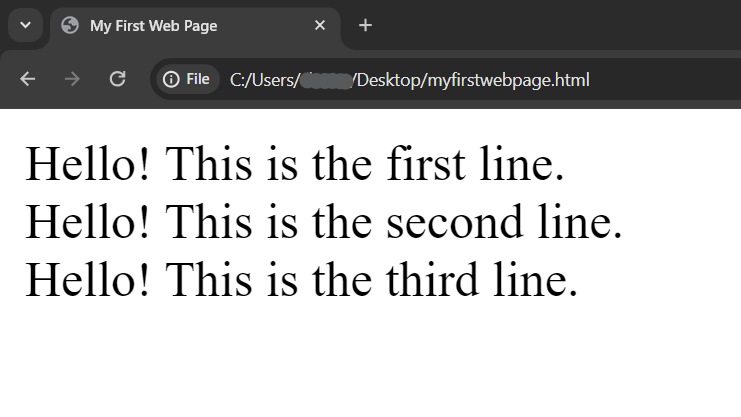Introduction
Understanding HTML text elements is crucial since much web content is text-based. This lesson will explore fundamental text elements used in web development.

Fundamentals Course
Understanding HTML text elements is crucial since much web content is text-based. This lesson will explore fundamental text elements used in web development.
In this lesson overview, you will find a comprehensive outline of the topics covered in each section.
Since you already know the basic structure of a webpage, let's now try to put contents in the webpage. Again, to show the contents in a webpage you need to put the contents inside the <body> and </body> tags.
<!DOCTYPE html>
<html lang="en">
<head>
<meta charset="utf-8" />
<meta name="viewport" content="width=device-width, initial-scale=1.0" />
<title>My First Web Page</title>
</head>
<body>
Hello! This is the first line.
Hello! This is the second line.
Hello! This is the third line.
</body>
</html>
In HTML, by default, consecutive lines of text are displayed without line breaks. In other words, multiple spaces, tabs, and line breaks in the HTML code are collapsed into a single space when rendered in the browser. Therefore, even though we have placed each line of text on a separate line in the HTML code, they appear as a single continuous line in the browser.
To create a new line in the rendered output, we need to use the line break tag <br /> after each line of text that we want to appear on a new line. Let's modify the HTML code to include line break tags:
<!DOCTYPE html>
<html lang="en">
<head>
<meta charset="utf-8" />
<meta name="viewport" content="width=device-width, initial-scale=1.0" />
<title>My First Web Page</title>
</head>
<body>
Hello! This is the first line.<br />
Hello! This is the second line.<br />
Hello! This is the third line.<br />
</body>
</html>
In HTML, the <p> defines the start of the paragraph and the </p> defines the end.
<p>This is a paragraph.</p>The defaults of the paragraphs:
Paragraph <p> can be nested, for now there is no magical like happening but in some later lessons you will appriciate them.
<p>
This is a paragraph.
<p>
This is the first nested paragraph.
</p>
<p>
This is the second nested paragraph.
<p>
This is a nested paragraph in a nested paragraph.
</p>
</p>
</p>
The result explains the behavior of block elements, each of the <p> tags occupy a whole line, and the spacing above and below them is constant.
The HTML heading elements are very important when determining the style and structure of text within web pages.
There are six section heading elements, <h1></h1> to <h6></h6>. <h1> being the largest size by default and most important by search engines. <h6> being the smallest and least important of the text headings within a web page.
You will discover additional resources and references to further enhance your understanding of the lesson topics.